What does your Nativity Scene mean?
There's a lot more Biblical and spiritual stuff going on than you think
This year the Vatican has created the Nativity Scene in St. Peter’s Piazza as a conscious tribute to St. Francis of Assisi and the first Nativity or Presepe he arranged 800 years ago in the tiny town of Greccio. So I thought it would be an appropriate moment to give some details about where we get the “classic” Nativity Scene - Mary and Joseph and the Infant Jesus, with the ox and the donkey, the lamb and the shepherds and the angel - that we all know so well.
While we are very familiar with this beloved custom, we might not be aware of the depth of spiritual realities it depicts.
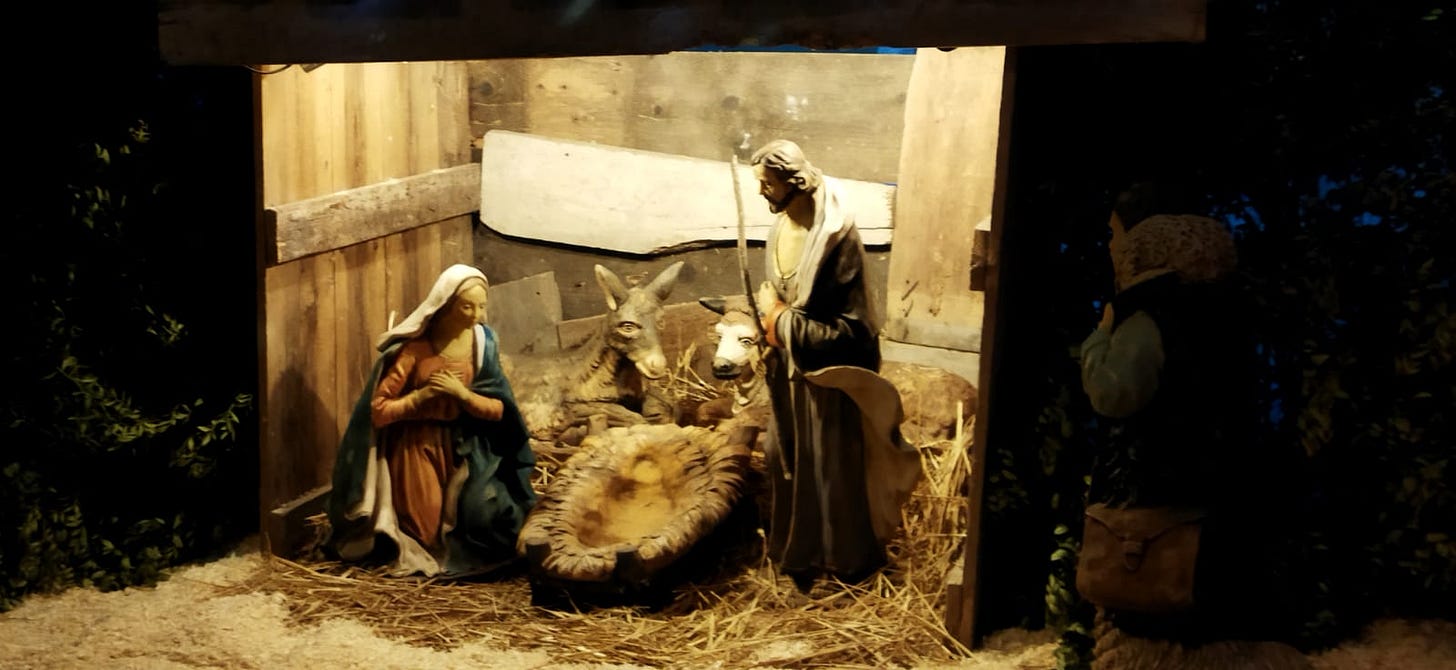
Yes, it’s Biblical
Until recently it would never have occurred to me to accuse Catholics of having made it up, but apparently in some Protestant circles there is some anxiety about this custom.
I ran across something on Twitter the other day that rather shocked me: someone claimed that the Nativity Scene “isn’t Biblical” and seemed to imply that he thought it was idolatrous in some way. Now, I’m the first to admit I know next to nothing about American Protestantism, but this seemed just plain weird. He added that it couldn’t be found anywhere in the Book of Acts… I was left blinking at the sheer non-sequiturness of it. Authentically Christian things can only come from the Book of Acts? Where do you even start with that?
I have never lived in the US and never really had any personal interaction with Fundamentalist Protestants; I’m pretty sure I wouldn’t know how to talk to them about anything religious. But since nearly all my readers are from the US and probably have to deal with this kind of thing from time to time, I thought maybe y’all could use some help, so I’ll trace the custom back to its roots in the early centuries of Christianity, and its sources in Scripture. And, as always, it’s a nice chance for some Christmassy sacred art eye-candy.
The custom is ubiquitous in Italy
Everyone who does them probably already has their Nativity scene set up. In Italy it’s the main decorative thing people do for Christmas; they’re absolutely everywhere. Christmas trees have caught on in recent years and live trees are easier to get, (usually with the root ball attached so you stick it in a pot of soil - and then don’t know what to do with it for the rest of the year) but they’re still not as omnipresent as they are in Anglosassone Land. There’s no such thing as a tree lot here.
The Nativity sets, called “Presepe” in Italian (from the Latin praesaepe, manger) range from the life-size figures set up in the main piazzas by the municipalities to tiny little figures set inside any available nook or cranny in your office or workplace.
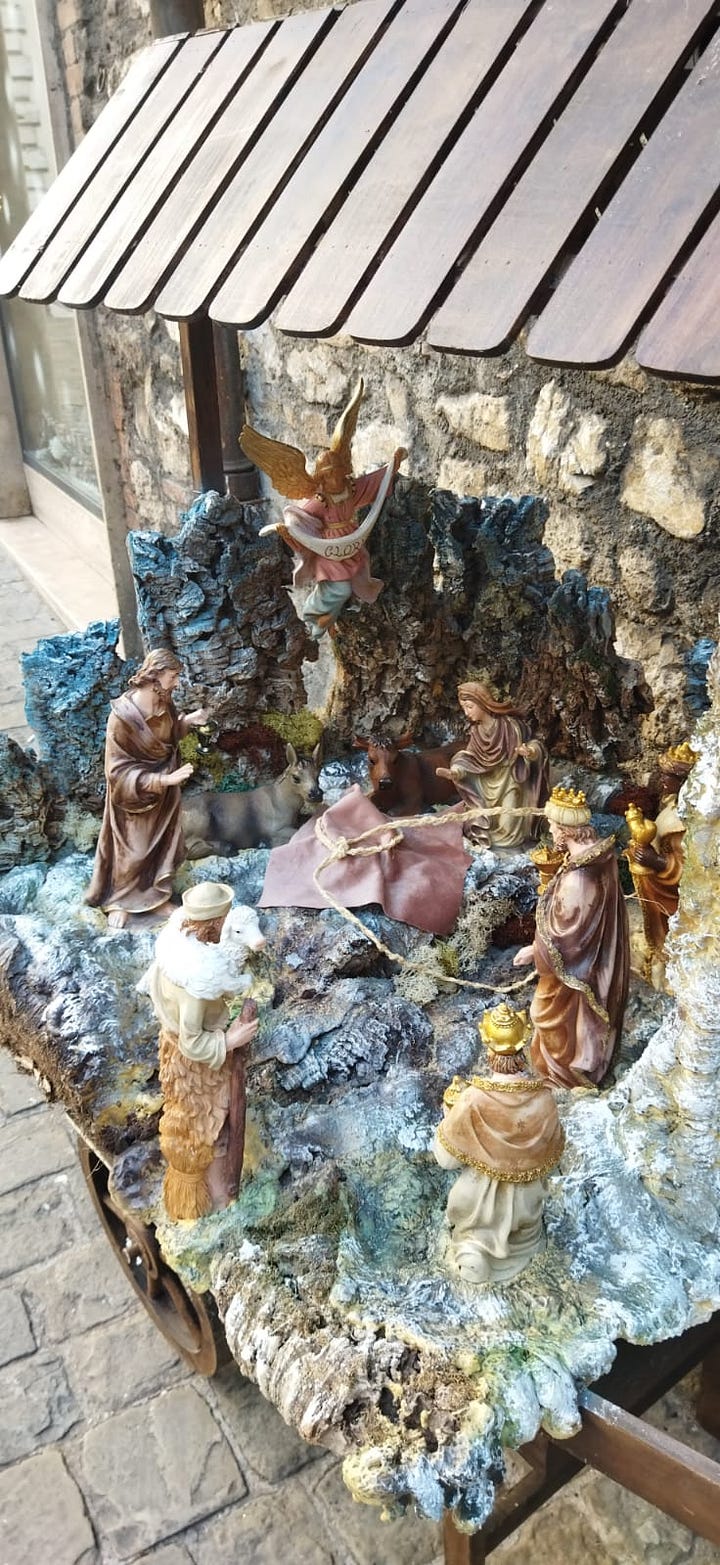
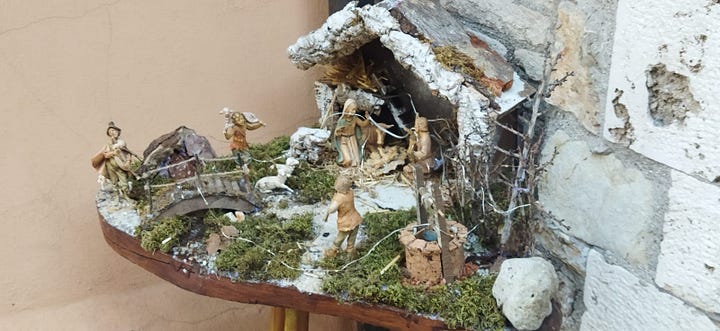
In Narni, apart from them being in every government office, shop, bar and restaurant, there is a whole street on which the townsfolk compete with each other for sweetest, most imaginative setting and nicest presentation. Dozens appear in every crevice large or small in the space of about 50 metres.

So deeply is the Presepe embedded in Italian culture that there is a whole industry producing not just the figures but all the little bibs and bobs that go along with them, including scenery and miniature buildings and all manner of decorations.
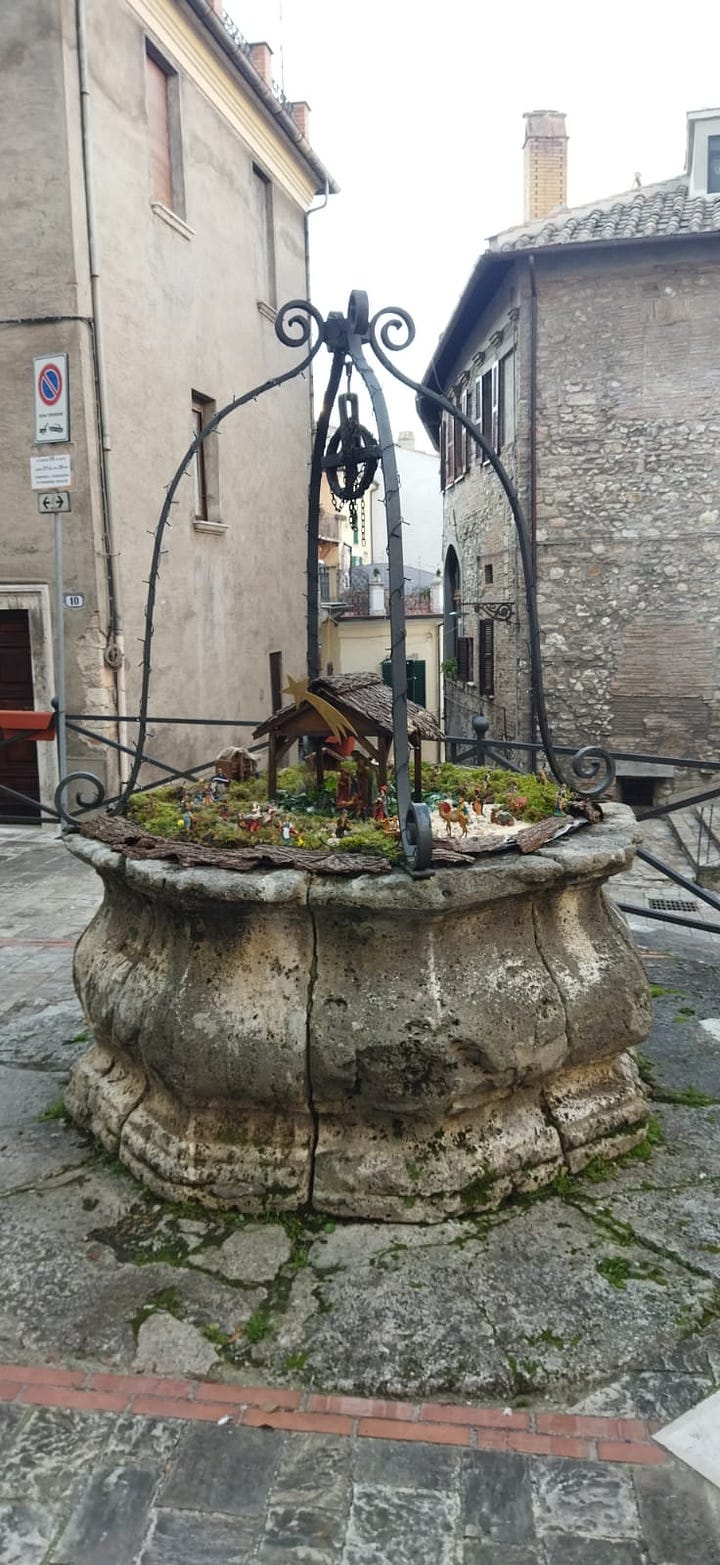
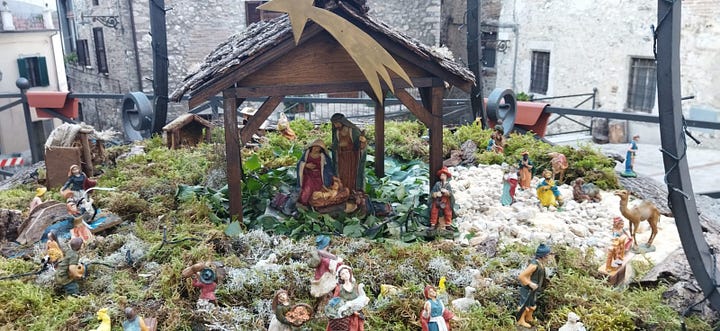
The Neapolitans and Sicilians especially have a corner on this cultural market. The Presepe can take up huge spaces - in Norcia they have the space of an entire deconsecrated church filled every year and you walk through the miniature landscape on a wooden walkway.
The large elaborate scenes also incorporate nostalgic memories of Italian town and village life of the Middle Ages, showing shops and tradesmen, glimpses of streets and homes from the past, employing very clever visual trompe l'oeil effects like forced perspective.
Most of this level of artistry is done by family businesses who have passed the profession down for generations, but it’s certainly possible to choose it as an artistic career in this country. Others take it up as a hobby, buying more figures and decorations and building more elaborate sets as the years pass.
You can even take courses:
Yes, St. Francis started them…sort of.
All Catholics used to be taught at their grandma’s knee that the Nativity scenes we like to have in our homes in Advent, Christmas and Epiphany were invented by St. Francis of Assisi, and this is partially true. The custom of setting up a little Nativity Scene spread throughout Italy and then taken abroad by the Italian emigrant diaspora in the late 19th century.

The idea of a living Presepe - where people dressed as the characters and presenting “tableaux” at various points of a course the townspeople walk in a procession - is also still observed in some parts of Italy and this was the first that St. Francis organised in the little hillside village of Greccio, about 60 miles north of Rome.
This living Nativity is still held annually in Greccio, with a Mass and candle light procession, as a kind of Nativity Play, and is well attended. The first was held on Christmas Eve 1223 in a tiny cave above the village, which Francis had fitted out with a simple manger, ox and donkey. A chapel was later built over the spot and decorated with frescos in the 14th century.

St. Bonaventure describes the scene
“It happened in the third year before his death, that in order to excite the inhabitants of Grecio to commemorate the nativity of the Infant Jesus with great devotion, [St. Francis] determined to keep it with all possible solemnity; and lest he should be accused of lightness or novelty, he asked and obtained the permission of the sovereign Pontiff.”
“Then he prepared a manger, and brought hay, and an ox and an ass to the place appointed. The brethren were summoned, the people ran together, the forest resounded with their voices, and that venerable night was made glorious by many and brilliant lights and sonorous psalms of praise. The man of God [St. Francis] stood before the manger, full of devotion and piety, bathed in tears and radiant with joy; the Holy Gospel was chanted by Francis, the Levite of Christ. Then he preached to the people around the nativity of the poor King; and being unable to utter His name for the tenderness of His love, He called Him the Babe of Bethlehem. A certain valiant and veracious soldier, Master John of Grecio, who, for the love of Christ, had left the warfare of this world, and become a dear friend of this holy man, affirmed that he beheld an Infant so marvelous sleeping in the manger, Whom the blessed Father Francis embraced with both his arms, as if he would awake Him from sleep (…)”.
And the charm and sweet simplicity of the devotion was so compelling it took over the whole Christian world. But what does it mean?
The basic set remains Mary and the Infant Jesus, St. Joseph, assorted shepherds, an angel and the ever-present animals in the stable, the lamb, ox and donkey. Many sets come with the Three Wise Men or Three Kings to add at Epiphany. Children are often delighted through the Christmas season as the three Magi are moved closer every day to the Presepe until the morning of Epiphany when they are presenting their gifts to the promised King."
But did St. Francis invent the scene?


The depiction of the Nativity of Christ has been a canonical subject for iconography for much longer than 800 years and it doesn’t start in Italy. Above is the famous Nativity of God icon by the famous 15th century Russian iconographer, Andrei Rublev, and a few other versions. If you look carefully at these images you will find every element we are familiar with from our dear childhood Nativity sets. By Rublev’s time this was the “canonical” - officially accepted-by-the-church - depiction of these sacred realities.
It doesn’t just tell us the historical story of events that happened 2000 years ago, but visually illustrates a whole spiritual framework; icons are always visual theology.1
The Rublev icon
In the Orthodox and Eastern Catholic world, the Rublev icon is regarded as the standard depiction. So let’s look at it closely.



You can see that there’s a lot packed into these traditional depictions of the Nativity, a whole narrative one would say. And it’s important to remember that in traditional iconography, we aren’t seeing a scene as though it was a snapshot taken by a time-traveller with a camera. This is a symbolic depiction of spiritual realities that we are expected to understand. And this is why icons often show a lot of different events as though they’re happening all at once.
The rocky background, with its imposing mountainous terrain, dry and inhospitable, represents the world after the Fall, that was made hard for man to live in, expelled from the delights of the earthly paradise. This is a reflection of the scriptural passages that tell us the Child, while still within His mother, was turned away by the people of Bethlehem - “His own received him not” - and had to camp in a stable.
The Christ child in His swaddling clothes, bands traditionally wrapped around an infant to hold him safely still, depicts the helplessness which He voluntarily undertook at His incarnation.
The cave and the animals guarding Him symbolise the loving welcome of the natural world for its Creator.
The incarnation meant that the Creator of the universe would be subject to death: the manger looks like a casket, the swaddling clothes remind us of a winding sheet in a grave, and the cave echoes the tomb that is to come. Christian liturgy links the Christmas story closely to the passion, death and resurrection of Christ and His coming at the end of time.
The light of the star comes down in three rays, representing the Holy Trinity, the “light of the world”.
The midwives have taken the Child and are washing Him after birth, as a further sign of the completeness of His humanity and His need for care.
Why is there always an Ox and Ass? That’s not in the Bible!
“The ox knows his owner, and the ass his master’s crib: but Israel has not known me, and my people have not understood.”
Yes it is; it’s just not in the place you’ve been looking. We remember that, despite the fashion of the Italian Presepe to show what life was like in 16th century Naples, the icon of the Nativity is not to be seen as a window onto a single past event. This is a set of very specific symbols intended to illustrate theological realities, and those have depths and nuances.
As we all know, the “infancy narratives” are found in the Gospels of Luke and Matthew. Mt 1.1–2.23 and Lk 1.5–2.52. And these are where we find nearly all the elements of the canonical iconography, and our Italian Presepe.
All except for one thing: the ox and ass.
We might not have thought much about it. The presence of sheep is explained by shepherds, and of course by the symbolism of the Lamb of God. We might have assumed that oxes and asses are simply the sort of animals one would have expected to find in a stable. And of course, that’s true. But why those two, why not horses or cows or goats? And why is their depiction so absolutely unfailingly present?
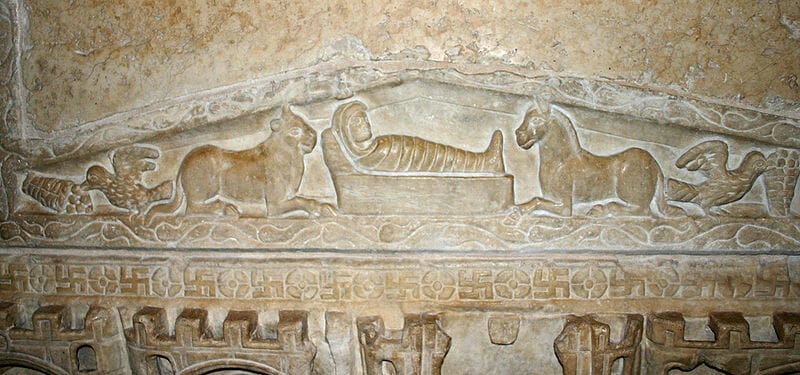
The representation of the Nativity with the ox and ass, as you can see in the image above from the 5th century stone sarcophagus, is of extreme antiquity. In a homily on the Gospel of Luke, Origen2, says the manger in which Christ was laid “was that very one, which the prophet foretold, saying, ‘The ox knoweth his owner, and the ass his master’s manger.’”
This is a reference to the opening of the book of the Prophet Isaiah3, “Hear me, you heavens! Listen, earth! For the LORD has spoken: ‘I reared children and brought them up, but they have rebelled against me.’
“The ox knows its master, the donkey its owner’s manger, but Israel does not know, my people do not understand.”
This rebuke is echoed throughout the story of the Nativity, with the Child being turned away from every door, finally having to be born in a stable. It is found again in the Prologue of the Gospel of John that says Christ is…
“the true Light, which lighteth every man that cometh into the world. He was in the world, and the world was made by him, and the world knew him not. He came unto his own, and his own received him not.
To Origen also, the ox and the ass represent the Jews and the Gentiles respectively, the ox being among the “clean” animals Jews were allowed to eat and the ass the unclean. There was a Mosaic law that prohibited yoking together an ox and an ass for ploughing.
We recall the vision of St. Peter where Christ showed him on a kind of screen dropped from heaven that all animals were now clean for him to eat. This is not simply the correction of Peter’s judaizing ideas - that would later be confronted directly by Paul - but the message that the salvation of Christ was for all people, not only for the Jews. So in the depiction of the Nativity, the ox - the Jews - and the ass - the gentiles - are united in adoring Christ’s sacred humanity. These two creatures are now “yoked” together at the Incarnation.
The association of the ox and ass with the Nativity of Christ, and its echoing of the Old Testament’s rebuke of the Jews for abandoning God, was found again in a seventh century text by an unknown writer, an apocryphal Infancy Gospel titled “On the Origin of the Blessed Mary and the Childhood of the Saviour”. This text explicitly associates the prophecies of Isaiah and Habakkuk4 with the events surrounding the birth of Christ:
And on the third day after the birth of our Lord Jesus Christ, the most blessed Mary went forth out of the cave, and entering a stable, placed the child in the stall, and the ox and the ass adored Him. Then was fulfilled that which was said by Isaiah the prophet, saying: ‘The ox knoweth his owner, and the ass his master’s crib.’ The very animals, therefore, the ox and the ass, having Him in their midst, incessantly adored Him. Then was fulfilled that which was said by Habakkuk the prophet, saying: “Between two animals Thou art made manifest.”
The ancient Latin liturgy of the Catholic Church, on the Octave day of Christmas, the feast of the Circumcision, includes the following verse and response:
V. Blessed and venerable art thou, O Virgin Mary, who without touch of shame, wast found as the Mother of the Saviour: * He laid in the manger, and shone forth in Heaven.
R. O Lord, I have heard Thy report, and was afraid: I considered Thy works, and grew fearful: in the midst of two animals Thou shalt be known.
Read more here: The Ancient Origins of the Nativity Scene (Part 1)
Thanks for reading all the way to the end. I hope you enjoyed this exploration of our familiar Nativity Scene customs. If you’d like to help me continue this work, please feel free to visit my studio blog, Hilary White; Sacred Art, where you can drop a donation, sign up to become a monthly patron, or buy something from my shop. It’s not too late to get some Christmas things in time if you’re ordering from the US.
Click here:
The “icons are visual theology” issue is why in the Orthodox and Eastern Catholic Church it is held to be as important to get an icon exactly right as it is to translate and transcribe Scripture accurately.
Origen of Alexandria, c. 185 – c. 253
The Office of Matins in the Monastic Divine Office on first day of Advent (the first day of the liturgical year) opens with the first chapter of Isaiah. If you want to really enter into the meaning of Christmas, that is, the great mystery of the Incarnation of Christ, the Office is the indispensable object. Isaiah is the Old Testament prophet of the Incarnate God, and therefore the Matins readings focus on him for the whole season of Advent.
Habakkuk’s prophecy of the Incarnation: “O Lord, I have heard Thy report, and was afraid: I considered Thy works, and was amazed: in the midst of two animals Thou shalt be known; when the years draw nigh, Thou shalt be acknowledged; when the time is come, Thou shalt be manifested; when my soul is troubled, in wrath Thou wilt remember mercy.” The two animals in this passage of Habakkuk were interpreted by some Church Fathers to be the ox and the ass of Isaiah 1:3, and/or the two criminals that flanked Jesus at the Crucifixion.




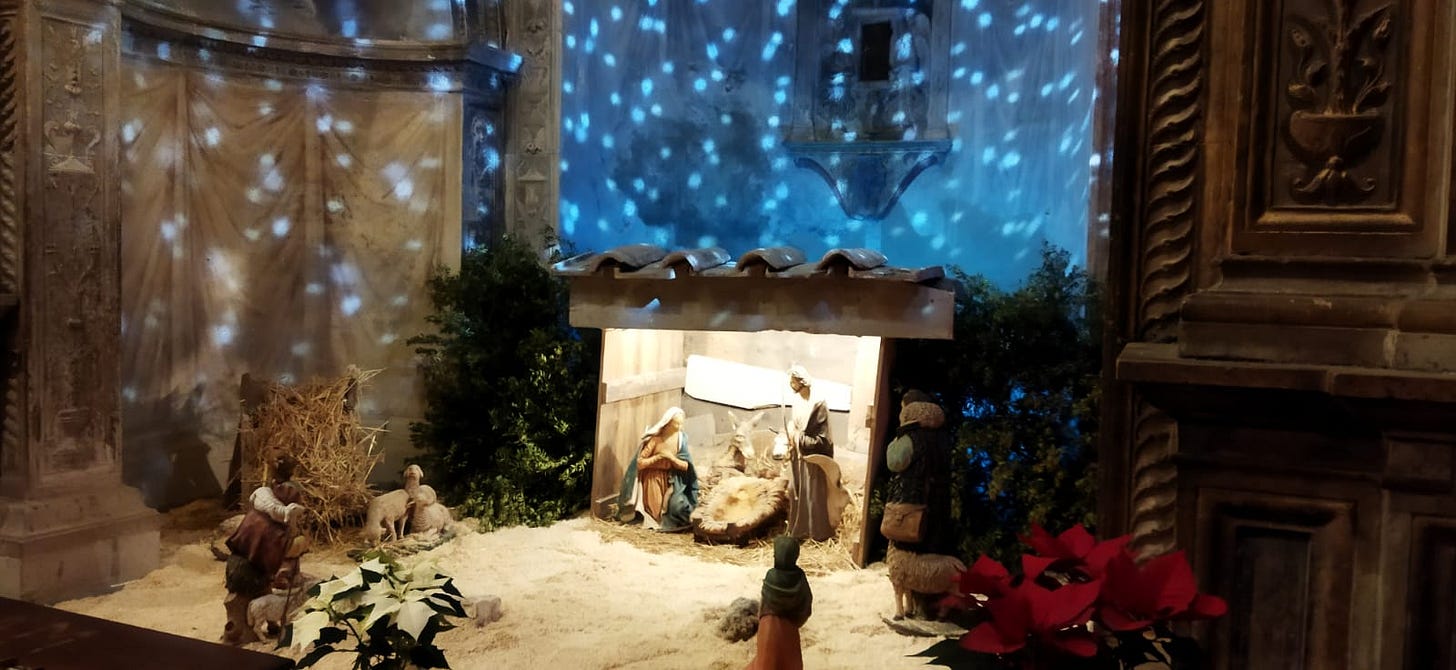



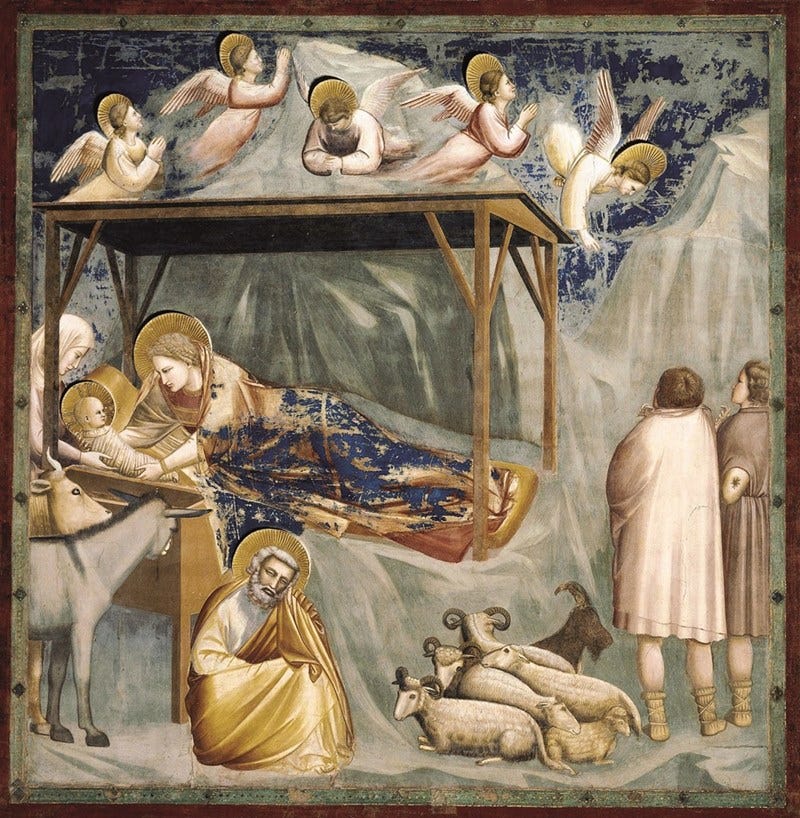
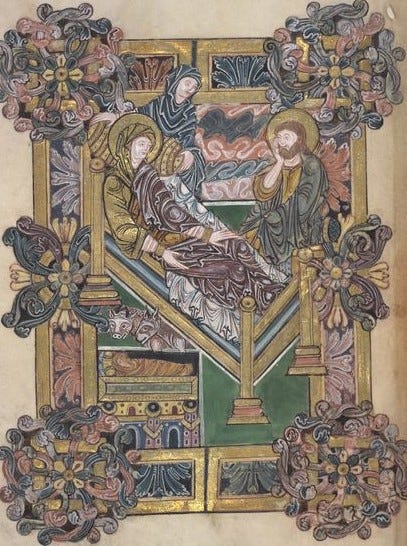
Thank you! Read this aloud to my teenager and husband while looking at our nativity set.
Wonderful, timely, much appreciated.
"the ox - the Jews - and the ass - the gentiles" -- Oh but this is informative.
I'm American and we're a funny bunch. Even the "Trads" fight amongst themselves here, so far have we fallen from the intentions of those who Founded this country. If you want proof, just watch the replies this comment will get.